K9 Water Search and Rescue
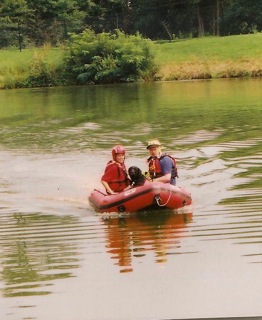
Water Search TSAR Team
Using canines to help locate a drowning victim can save hundreds of man hours.
If you're interested in training your dog as a Water Search and Recovery K9, you want to be sure your dog is up to the challenge. This specialized training requires both the handler and dog to be fit and possess a calm disposition.
Canines over 3 years old are more suitable for this task, as they have overcome the immature stage and are more able to concentrate for longer periods of time. You also want a dog that is acclimated to water. Retrievers and Pointers are a good example.
You need to determine what your dog's primary drive is. Does he get excited for food or does a toy drive him crazy? What reward system will you be using?
Also determine if he considers water search to be fun, or boring? Some dogs need instant gratification, and become bored if the find takes too long. If he's excited about water search, you are already one step ahead.
When training, do not use complex problems to start. Shallow, calm waters with only a slight wind would be prime conditions. Always work into the wind, as this gives him a bit of an advantage. Let him cool off and relax in the water on hot days. This will help him relate fun activities with the training.
Training Your Water Search K9
Most canines trained in water search already have the knowledge of Wilderness Air Scenting, and/or Cadaver, making the training much easier. He will already understand how to alert you and you will have a good idea of how to read your dog.
The first step to training your K9 is getting him comfortable in the boat. He needs to be able to enter, exit, and ride in a controlled manner. Everyone has their own space on the boat. Your dog's is the bow, or front. Make sure the space is comfortable. A piece of outdoor carpet works well and will help with traction too.
The space directly behind the dog is for the handler. Make sure you're close enough to accurately read his alert. If you need to add an extra seat in the boat, then do so.
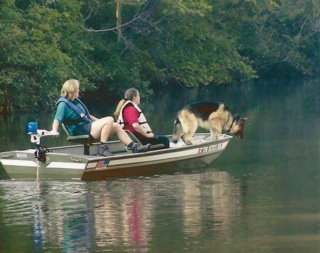
Water Search K9 "Klink"
Most search and rescue handlers introduce their dogs to human scent underwater using a diver wearing scuba gear. The diver submerges himself a few feet underwater and lingers there. When the boat passes downwind of the location of the diver, your K9 should alert you.
As soon as the dog alerts, the handler should immediately reward him. Both the handler and the diver should reinforce the dog's alert when he hits on the human scent. The best way to signal the diver to come to the surface is to use a piece of fishing line, and have a helper from the shore signal the diver.
Once your dog has learned that human scent can come from under the water, all he has to do is alert. It's your job as the handler to recognize his body language and act on it. It is a continuous learning process for the handler.
Water Search Tip
**Be careful not to reward false alerts. A common mistake handlers tend to make is reinforcing the dog's alert, when the handler thinks the dog has picked up on a scent. If the scent isn't there, then you are confusing your dog by rewarding for nothing. The dog thinks you are rewarding him by responding to a particular motion from the handler instead.
Always know where your scent material is. Trust your dog to find the scent and do the alert. They are experts in detecting scent, we are not.
Choosing A Water Craft To Use
The less distractions there are for the K9 and handler, the better. Your boat should be comfortable for two adults and one canine. Training on too large of a vessel with too many people just doesn't work.
Too much talking, and moving around can become hopelessly distracting to both you and your K9. A boat size of 16-18 feet works well.
Types of Water Search
There are many types of search areas, so search skills may vary from one place to another. Here are some examples of the different areas a water search might be performed.
- Lakes and Ponds can be large or small, deep or shallow, natural or man made. One common feature in all lakes and ponds…they are a natural containment area. If there is a victim in the water, they will be there until they are found.
- Quarries Are usually spring fed, and are very deep with underwater cliffs and caves. They also offer natural containment features.
- Non-Tidal Swamps and Marshes These can be as dangerous to the searcher as to the victim. Poisonous snakes, thick mud and grassy vegetation will have an affect on the way you search the area and the flow of the air currents. Marshes and swamps are also natural containment areas.
- Flooded Valleys which are formed by dams can cause extremely large lakes. These lakes are usually very deep and cold. Some flooded valleys have very steep shorelines, submerged trees, bridges, or other debris, which can become a major hazard for divers and searchers.
These flooded valleys can also be considered a natural containment area. The scope of the search can be influenced by water currents and strainers in this type of area.
- Tidal Waters will have their own currents, which will affect the location of the victim. Tidal Marshes may have deep mud which can hold a small victim in place. Tidal waters except for marshes are not considered to have natural containment features, so consulting locals and finding more info of drowning history in the area may help to determine where to search.
- Streams and Creeks can vary in their size and flow. They may be wide, narrow, shallow or deep, and some may have sandy or rocky bottoms while others are muddy. There may be deep holes or ledges. Some may flow straight, or have many curves and bends. The currents can be affected due to these features.
The condition of the stream may be different during the search than the time of the actual drowning. The only containment a stream or creek has is the banks. This is only true in a non-flood condition. If the victim is in the water, it is possible they could be 20 or more miles downstream from the PLS (Point Last Seen).
- Rivers will vary in size and flow also. They may have the same characteristics as a creek or stream, only on a much larger scale. Rivers may have islands, dams, eddies, and strainers, overhead objects and other hazards for victims as well as the searchers. Containment in a river is almost impossible especially during a flood.
Water Safety
Water Safety is a must for you and your dog! 90% of the victims you're searching for are out there because they didn't wear a personal floatation device. If you are 10 feet or closer to the shoreline, then you should be wearing a PFD!
There are different opinions on whether your dog needs to wear one also. It is at the discretion of the handler, but they do make some nice PFD's for dogs.
Hazards On The Water
Always remember that while you're out looking for the victim, this is a recovery, not a rescue. You don't want to be taking any chances that would put you or your dog's life in unnecessary danger.
The thing about hazards on the water….they are also good places to look for your victim.
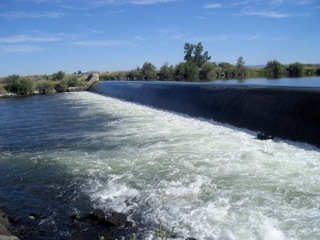
Low Head Dam courtesy of Fremont Rescue.org
- Low Head Dams, also known as drowning machines, are man made structures, six to ten feet high spanning a river or stream. Do NOT try to "run" the dam. You may get caught in the "boil" or "backwash" and become trapped. There have been many rescues and recoveries due to people not listening to the warnings.
If you find yourself caught in a low head dam, ride the vertical eddy to the bottom of the dam, stay close to the bottom and swim downstream until you clear the boil area. This is a very difficult thing to do, but if your a strong swimmer, and don't get caught in any debris underneath, it could save your life. Low head dams are extremely dangerous, even deadly. If you are doing a water search near these dams, take these warnings seriously!
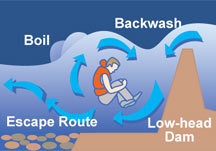
Finding the drowned body
There are conditions at the scene that will affect how and where you search for the subject.
Air temperature and wind can have an affect on the emerging scent from the water. A water temperature of 38 degrees or higher can cause the victim's body to decompose and form gases, changing the buoyancy and cause the body to rise to the surface.
Lakes and ponds do not usually have a current like a river, but the force of wind on the surface of the water can cause your boat to feel as if it is drifting. This is why some lakes and reservoirs have a flow-type current. Water being released from a dam can cause this type of current.
Streams, and rivers have bends. The weight of the water can cause undercutting of the bank. Friction can cause a change in the flow, as faster current will be present of the outside curve, and slower on the inside. Watch for shallow areas known to form on the inside of the bends.
Death from submersion can occur within two minutes or less. Sometimes people that are still alive when rescued die later from asphyxiation. Once death occurs, the body becomes a cadaver, and react differently depending on conditions.
Usually within the first 24 hours of a search, the victim still has the live scent, so using a scent article to locate the victim could be helpful a this time.
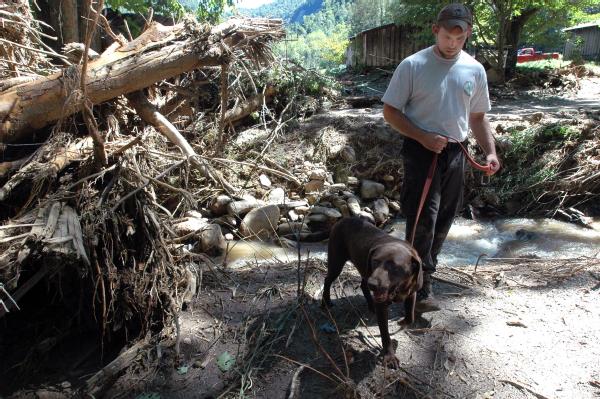
Photo courtesy of FEMA.Photographer Leif Skoogfors.
Before you start your water search, you will want to know information about the incident, how much time has lapsed, because conditions can change. K9 teams can work from the shoreline, or a boat. The air currents carry the scent of the victim rising from the water across and the dog can pick up the scent and alert the handler.
You should have knowledge of the water search areas, including topo maps before heading out. Teams that will search rivers with fast currents should understand river hazards and take the necessary precautions.
Return from "Water Search " to "Training Your Search and Rescue K9"





